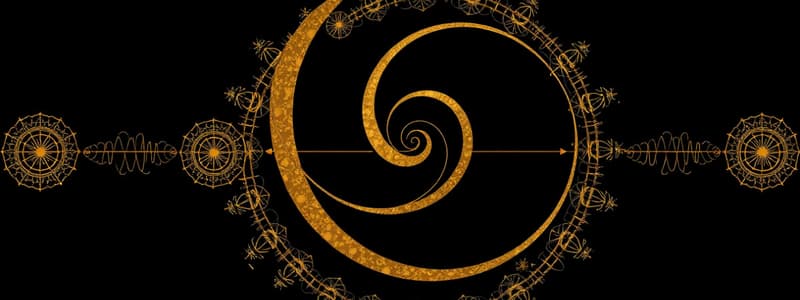Podcast
Questions and Answers
What defines a fractal pattern in nature?
What defines a fractal pattern in nature?
A fractal pattern is a detailed design that appears similar at any scale and repeats itself, becoming more complex as it is observed at larger scales.
How is the Fibonacci sequence created?
How is the Fibonacci sequence created?
The Fibonacci sequence is created by starting with 0 and 1, and then each subsequent number is the sum of the two preceding ones.
In what natural forms can the Golden Ratio be observed?
In what natural forms can the Golden Ratio be observed?
The Golden Ratio can be observed in forms such as pine cones, sunflowers, and nautilus shells.
What is tessellation, and how is it characterized?
What is tessellation, and how is it characterized?
Describe what a Voronoi pattern reveals about nature.
Describe what a Voronoi pattern reveals about nature.
What are spirals in nature, and where can they be found?
What are spirals in nature, and where can they be found?
Why are patterns and regularities in nature important?
Why are patterns and regularities in nature important?
What is symmetry, and why is it significant in nature?
What is symmetry, and why is it significant in nature?
Flashcards
Patterns in Nature
Patterns in Nature
Recurring forms and structures found in the environment.
Fibonacci Sequence
Fibonacci Sequence
A sequence where each number is the sum of the two preceding ones, starting at 0 and 1.
Golden Ratio
Golden Ratio
A ratio derived from the Fibonacci sequence, often related to beauty and efficiency in nature.
Fractals
Fractals
Signup and view all the flashcards
Voronoi Patterns
Voronoi Patterns
Signup and view all the flashcards
Spirals
Spirals
Signup and view all the flashcards
Tessellation
Tessellation
Signup and view all the flashcards
Symmetry
Symmetry
Signup and view all the flashcards
Study Notes
Patterns in Nature
- Patterns in nature can be identified through recurring forms, structures, and processes observed in the environment.
- Examples include the arrangement of leaves, the symmetry of flowers, and various animal patterns.
Nature of Mathematics
- Mathematics serves as a language to express relationships and regularities found in nature.
- It is often represented using numbers, symbols, and equations to model real-world phenomena.
Fibonacci Sequence Creation
- The Fibonacci sequence begins with 0 and 1, with each subsequent number being the sum of the two preceding ones.
- The sequence can be written as: 0, 1, 1, 2, 3, 5, 8, 13, and so forth.
Instances of Fibonacci Sequence
- The Golden Mean, Golden Ratio, Golden Spiral, and Golden Rectangle are related through ratios found in the Fibonacci sequence.
- Manifestations include the arrangement of seeds in sunflowers, the branching of trees, the patterns of hurricanes, and the growth of shells.
Importance of Patterns and Fibonacci Sequence
- The study of patterns aids in understanding natural phenomena and biological structures.
- The Fibonacci sequence and associated patterns highlight the inherent efficiency and beauty present in nature.
Fractals
- Fractals are complex patterns that exhibit self-similarity at different scales, becoming more intricate when observed from larger perspectives.
- Examples include snowflakes, branching trees, and fern leaves.
Voronoi Patterns
- Voronoi patterns reflect nature’s efficiency through the concept of nearest neighbors and optimal packing.
- Observations can be seen in structures like giraffe skin, corn kernels, honeycomb formations, and leaf cells.
Spirals
- Spirals are curved patterns revolving around a central point, characterized by a series of circular shapes.
- Common examples are found in pine cones, pineapples, and the structure of hurricanes.
Tessellation
- Tessellation is a method of tiling a plane using one or more geometric shapes with no gaps or overlaps.
- Types of tessellations include:
- Regular Tessellation (using one type of regular polygon)
- Semi-Regular Tessellation (using two or more types of polygons)
- Irregular Tessellation (using shapes of varying sizes)
Symmetry
- Symmetry refers to a balanced and proportionate similarity on opposing sides of a central plane.
- Common in nature, symmetry contributes to aesthetic appeal and functional efficiency in biological structures.
Studying That Suits You
Use AI to generate personalized quizzes and flashcards to suit your learning preferences.





